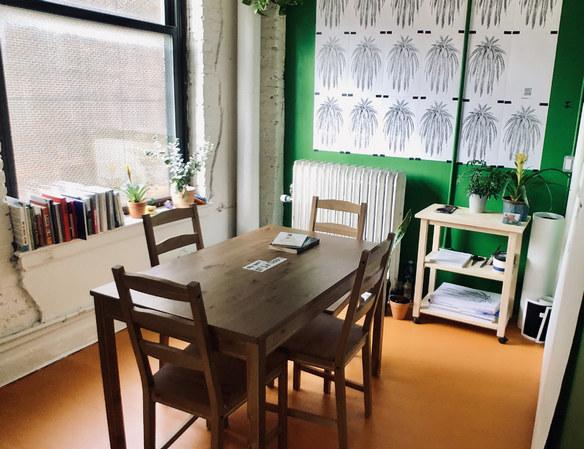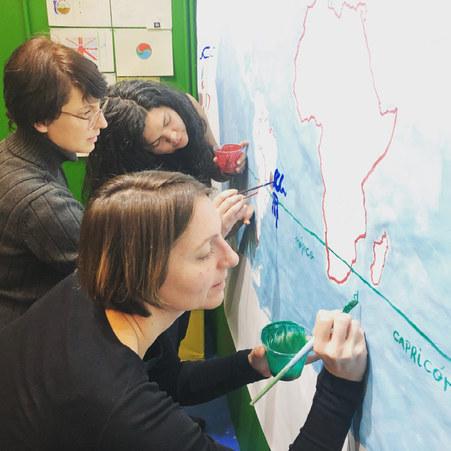
3 minute read
The School is Here
Learning happens beyond school.
Making art is how I examine the meaning of the tracks people leave when expressing ideas and moving on with their lives. This is my way of learning, and I believe that it can be shared and explored in a valuable way by others. As an educator, I reflect on the dynamics offered through classroom experiences—mainly those related to words, which are a sort of “fountain of knowledge and insights” that became part of my art-making process. Sometimes, my role is to cultivate and frame other people’s expressions and give them life as artworks.
Advertisement
Escola Aqui (2019-present)—from Portuguese1 meaning “school here”—is an itinerant collaborative learning space I created at the beginning of my Master of Fine Arts program at the School of Visual Arts (SVA). It hosts text-based2 workshops dedicated to collaborative studies in which facilitators propose discussions on subjects that are considered culturally relevant to their guests, thus providing an exchange between cultural and individual identities.
In-person or online, Escola Aqui learning experiences must be accessible and can happen anywhere, regardless of academic environments. The context of where it is activated is fundamental, and the use of the expression “aqui” (here) is a way of emphasizing this situational and fluid notion. The starting point of each session is an invitation to participants to attend the reading-writing-reading gathering. Such practices consist of creating new manuscripts or editing pre-existing text fragments through writing interventions, rewriting sentences, and changing the content’s physical form.
ESCOLA AQUI
17
A facilitator guides each session. Their knowledge, interests, and skills essentially define their proposal. Facilitators do not necessarily need to be artists or educators—they can also be poets, mothers, chefs, secretaries, politicians, fishermen, etc. What is relevant to each participant is how accessible the content is, defined not only by its style, but also by its format, which can be a profound and erudite paragraph from a philosophy book or an article in today’s newspaper. It can also be a single word.
Despite having a proposed model set in place, each session is unique and trusting of the potency of interpretations and individual discourses. This is what I imagine: a basic instruction transformed and adapted, giving space to imagination, self-expression, and freedom of speech.
After the facilitator gives the fundamental instructions, participants start to create their versions of the word, the sentence, the paragraph, or the whole text presented in a way they believe makes the most sense during the gathering. It is this part of the process—bringing in particular points of view—that may differ from the author’s (when there is an author). It’s never just about agreeing or disagreeing, but comparing, contrasting, and committing to voicing their own opinion. In this artwork, participatory and/or collaborative activities establish a particular space-time where everyone feels comfortable taking the risk of showing vulnerability and exercising freedom and autonomy. This trust-based relationship between facilitator and participants is vital.
Pieces of paper and online real-time collaborative text editors are the mediums that are transformed by the editing-writing intervention. In the discussions, when everyone shares their textual versions, different voices manifest various sounds, revealing psychological and emotional content that complements the visual production.
18
ESCOLA AQUI
The work’s central component is ephemeral: our meetings, conversations, negotiations, and understandings are not tangible to outsiders. Escola Aqui’s aactivations consist of the participants’ experiences, which is not a sensory form that art spectators can appreciate immediately. But from images of the modified texts and recordings of the readings, I produced the works what makes brasil, Brazil (2019-2020) and Embromation (2020-2021), works in which the writings and voices of participants are incorporated as traces that viewers can access before they might consider their own participation. The result challenges understanding beyond the mastery of the language, while allowing reflections on power dynamics and discourse production. There are different levels of access to the works—a desirable outcome given that the contextual aspect is part of its composition. Cultural backgrounds may enhance or limit the way each viewer will understand the result.
In this work, collectivity and individuality live together, negotiating beliefs and establishing trust.
ESCOLA AQUI
19
Escola Aqui
Studio setup between 2019-2020. Configuração do ateliê entre 2019-2020.
20

Escola Aqui
Weekly meetings with Dani, Vivi, and Stephanie in the SVA studio between 2019-2020 (from front to back). Encontros semanais com (da frente para fundo) Dani, Vivi e Stephanie no ateliê da SVA entre 2019-2020.
21










